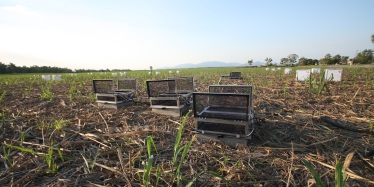Soils and greenhouse gases
Soils have the capacity to generate (source) or store (sink) greenhouse gases, depending on how they are managed.
Greenhouse gases absorb infrared radiation from the sun, warming the atmosphere.
The most well-known example is carbon dioxide (CO2) but other gases include methane (CH4) and nitrous oxide (N2O)—which have global warming potentials of 21 and 310 times carbon dioxide respectively.
Measuring soil greenhouse gases

Soil greenhouse gas studies are usually done at the paddock scale. One method to measure these gases is automatic chambers. Chambers are placed over the soil and automatically open and close, with air samples taken automatically and analysed on site by electronic-sensing devices.
Another simpler (but more labour-intensive) method is the use of manual chambers. Chambers are manually closed for a specified time at a particular time of day, gas samples are taken, stored in vials, and analysed in a laboratory.
The automatic chamber method enables frequent measurements (multiple times per day) while the manual chamber method is usually less frequent (3 times per week), but enables greater replication.
Outputs
Soil greenhouse gas outputs are not constant, often occurring in response to farm management practices (e.g. fertiliser application, tillage) and weather events (e.g. rainfall).
Queensland’s unpredictable climate makes these gas emissions even more irregular. A proper assessment must involve measuring inputs and outputs over a long period of time—preferably several years across 1 or more growing seasons.
Managing soil greenhouse gases
Strategies to manage greenhouse gas emissions, particularly N2O, from soil are a topic of current research for Queensland scientists.
Management strategies being investigated are:
- the use of polymer-coated urea fertiliser—this product slows down the release of fertiliser nitrogen so it is available when the crop needs it most, reducing potential leaching or gaseous loss
- the use of urea fertiliser with nitrification inhibitors—this product inhibits the conversion of ammonium-N to nitrate-N by specialised soil bacteria. It is only when nitrogen is in the nitrate form that N2O can be formed.
- reduced fertiliser application rates—assessing the potential for reduced fertiliser application rates to reduce N2O fluxes, while maintaining crop yield
- implementing legume rotations (particularly in the sugarcane production system)—legume crops such as soybean take up nitrogen from the air which can then be used by the following crop as the legume residues slowly break down forming mineral nitrogen and thus reducing the amount of nitrogen fertiliser required.
Mitigating greenhouse gas emissions, especially N2O, from agricultural land not only reduces the effect on the environment by minimising unwanted losses, but may also help farmers reduce their fertiliser use, while maintaining productivity.
For more information about our research email soils@qld.gov.au.